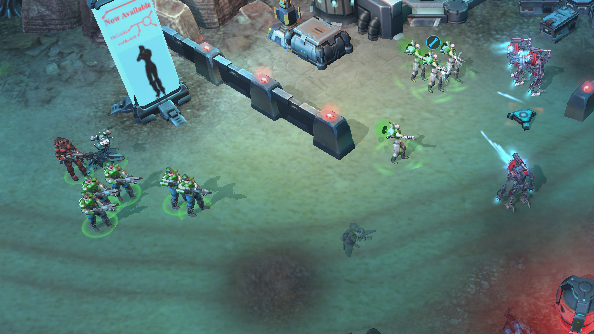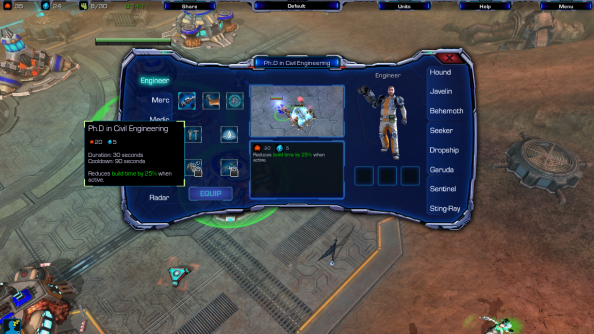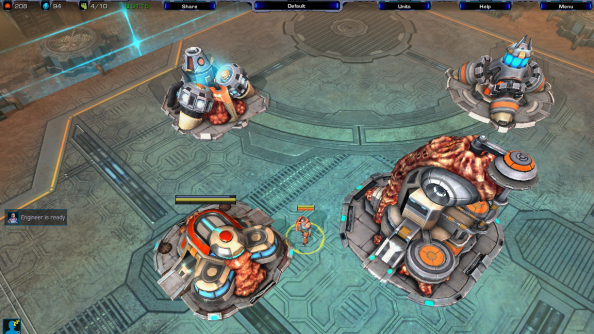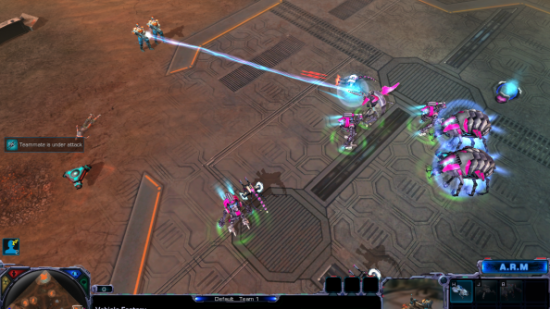Tryst is a sci-fi RTS with a difference. Or with two, in fact. First of all, it’s a fast-paced game, with most matches lasting twenty minutes or less, but it’s also a product of India’s fledgling video games scene. We talked with Vinnie Reddy and Julio Torres, of developer BlueGiant Interactive, about the project and about the growth of game development in India.
India
isn’t well-known for it’s video games industry, but like all the BRIC
nations (Brazil, Russia, India and China), it has a growing middle class
as a result of its developing economy, which means a growing market for
games. It also has more than its fair share of programmers and
developers among its burgeoning IT industry and while we may not know of
many PC or console games being either developed or embraced by India,
Reddy tells me that instead mobile gaming is very popular, and its this
that has partly inspired the pace at which Tryst plays.
“It’s
more of an action-packed RTS, something when you’re put straight into
the action, really,” he says. “I think the design came from our love for
both mobile games and RTS, so it is a unique spin, our own version of
an RTS which has that mobile pace. You form a quick strategy and you
finish a game in twenty, twenty-five minutes, and then you come back
again and try a different strategy. But there’s still enough depth and
enough choices for the player, and a lot of other features mixed in
there: RPG features, the cover system, loot drops, a limited ammo
system, line of sight and line of fire.”
BlueGiant
want you to get out of your base and right into the action, so build
times are fairly short and units are both fast and fragile. One wrong
move can spell disaster and the addition of limited ammunition, which
can be scavenged from destroyed units, adds an extra level of strategy.
“You
can have a lot of fun without needing hours and hours of gameplay,”
adds Torres. “At the same time, the customisation of all of the
different units is such that if you are that kind of hardcore player and
want to play longer, you do have an in-depth experience as well.” That
customisation comes in the form of buffs and passive and active upgrades
that can be granted to your units and structures, introducing new
abilities or boosting old ones.
While
Tryst also has a fully-developed single-player campaign, it’s clearly
designed to be a multiplayer experience. BlueGiant are all to aware of
the comparisons that the game has drawn to StarCraft II and they’re keen
to emphasise that this is a very different game made by a very
different studio. “We’re a very small team,” says Reddy “Twenty people
made the game in thirteen months, but the comparison is always to a
ten-year game with a massive budget. It’s a hard battle to win, but
we’re not trying to compete with them, we’re trying to say we’re a
viable alternative.”
BlueGiant
have a lot invested in this game, quite literally. Tryst is the result
of a learning experience after Apox, the developer’s previous RTS
effort, was poorly received both critically and commercially. The
resulting financial shortfall means the developers have had to fund the
game from their own pockets, with investment from friends and family,
since Indian banks have little interest in supporting games development,
something Reddy describes as “taboo” because it’s not yet associated
with success, big brands or respectable work.
“We’re
like hackers, you could say! Genuinely, we’re the hackers here,” he
explains. “When banks look at us – all those old school people – they
come in and look at us like ‘What the hell? You guys are kids. What’re
you doing? Games?!’ Getting funding for games is really hard. The
government’s focus is on mass employment and the games industry doesn’t
provide as much as IT or other similar services provide, so we’re always
under-represented, in all aspects.”
That’s
not to say this can’t change, and Reddy believes that as soon as one or
two Indian development studios achieve success, there will be more
interest and more investment in the industry. “I think it’s on the
rise,” he says. “Compared to eighteen or twenty-four months ago, when we
couldn’t find developers. Now it’s a lot easier, there’s a lot more
communication happening, we have our own small GDC here, locally,
happening in November. But the focus is definitely still on mobile or
portable games. There’s not much on the console, not much on the PC.
We’re the only ones doing anything in this style, this complex, of this
size.”
Certainly,
the skills and the infrastructure are already there, with BlueGiant’s
home city of Hyderabad enjoying a gradual growth of communications and
IT services, and more than enough capable programmers. During
recruitment, BlueGiant sifted through over 4,000 job applications to
fill just six development roles, and while larger PC and console-based
projects may not be widespread, India’s interest in mobile gaming
presents many opportunities for start-ups. “All this has been very much
the younger generation, people who are in their early 20s, just getting
into it, becoming entrepreneurs,” he says. “They don’t have have access
to large budgets so they’re trying something small. For them, mobiles,
iOS, Android are a good start.”
Meanwhile,
even if there isn’t an immediate interest in India, this is largely an
irrelevance, as Tryst will be available to gamers around the world via
Steam and Torres hopes it will find its audience amongst RTS veterans.
“The western world, the European market, those were definitely our
direction. That’s not to say that the studio isn’t trying to expand in
their local market but, for sure, that was the priority.”
Tryst
is released today, though BlueGiant are by no means finished with and
already plan to add further game modes and DLC in the months to come,
including new environments, skins, customisation options and a
“Supergun” mode, where players will race to collect and assemble
different parts of a gigantic weapon. It faces stiff competition from
its RTS peers, but if it really can demonstrate that its distinctive, it
could mean a big leap forward not just for BlueGiant, but for India’s
games industry.
